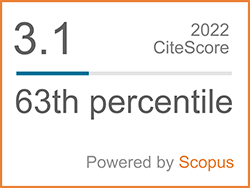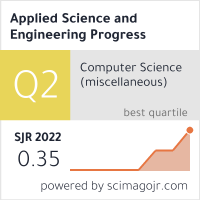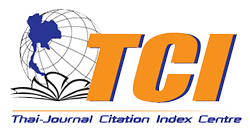Enzyme-Assisted Extraction of Fucosylated Chondroitin Sulfate from Sea Cucumber Holothuria scabra and Bohadschia argus and their Potential in Pharmaceutical Applications
Abstract
Due to the health benefit of fucosylated chondroitin sulfate (FuCS), the efficient method for extraction of FuCS from raw materials is a crucial issue in reducing the production cost. In this study, enzymatic extraction of FuCS from two species of sea cucumber, Holothuria scabra and Bohadschia argus was undertaken using two protease enzymes, alcalase and papain. Response surface methodology (RSM) was employed in determining the optimal extraction conditions with the highest yield of FuCS concentration. The predicted optimal papain-assisted extraction conditions of Holothuria scabra and Bohadschia argus obtained a predicted FuCS yield of 1609.73 mg/100 g and 444.51 mg/100 g, respectively. To compare extraction efficiencies of two protease enzymes, employment of the RSM optimal conditions to Holothuria scabra resulted in 1538.76 ± 20.26 mg/ 100 g and 1295.50 ± 14.28 mg/100 g of purified FuCS for papain and alcalase, respectively. Whereas Bohadschia argus produced 412.39 ± 10.12 mg/100 g and 461.11 ± 8.45 mg/100 g purified FuCS for papain and alcalase, respectively. The acquired FTIR and NMR spectrums of extracted FuCS showed typical bands of sulfation patterns and were compared to commercial FuCS. The extracted FuCS showed enzyme type dependent antioxidant activity, and significant tyrosinase inhibitory activity than commercial FuCS. It also exhibited similar anti-glucosidase activity as commercial FuCS. Thus, this study reveals potential applications of enzyme-assisted FuCS from sea cucumber in food and pharmaceutical industries.
Keywords
[1] N. P. Özer, S. Mol, and C. Varlık, “Effect of the handling procedures on the chemical composition of sea cucumber,” Turkish Journal of Fisheries and Aquatic Sciences, vol. 4, no. 2, 2004.
[2] A. Ardiansyah, A. E. A. Rasyid, R. Pangetistu, and T. Murniasih, “Nutritional value and heavy metals content of sea cucumber Holothuria scabra commercially harvested in Indonesia,” Current Research in Nutrition and Food Science Journal, vol. 8, no. 3, pp. 765–773, 2020.
[3] N. Volpi, “Chondroitin sulfate safety and quality,” Molecules, vol. 24, no. 8, p. 1447, 2019.
[4] T. N. Laremore, F. Zhang, J. S. Dordick, J. Liu, and R. J. Linhardt, “Recent progress and applications in glycosaminoglycan and heparin research,” Current Opinion in Chemical Biology, vol. 13, no. 5–6, pp. 633–640, 2009.
[5] B. Caterson and J. Melrose, “Keratan sulfate, a complex glycosaminoglycan with unique functional capability,” Glycobiology, vol. 28, no. 4, pp. 182–206, 2018.
[6] C. Xu, R. Zhang, and Z. Wen, “Bioactive compounds and biological functions of sea cucumbers as potential functional foods,” Journal of Functional Foods, vol. 49, pp. 73–84, 2018.
[7] E. A. Siahaan, R. Pangestuti, H. Munandar, and S. K. Kim, “Cosmeceuticals properties of sea cucumbers: Prospects and trends,” Cosmetics, vol. 4, no. 3, p. 26, 2017.
[8] S. Shi, W. Feng, S. Hu, S. Liang, N. An, and Y. Mao, “Bioactive compounds of sea cucumbers and their therapeutic effects,” Chinese Journal of Oceanology and Limnology, vol. 34, pp. 549–558, 2016.
[9] Y. Kariya, S. Watabe, K. Hashimoto, and K. Yoshida, “Occurrence of chondroitin sulfate E in glycosaminoglycan isolated from the body wall of sea cucumber Stichopus japonicus,” Journal of Biological Chemistry, vol. 265, no. 9, pp. 5081–5085, 1990.
[10] P. A. Mourão, M. S. Pereira, M. S. Pavão, B. Mulloy, D. M. Tollefsen, M. C. Mowinckel, and U. Abildgaard, “Structure and anticoagulant activity of a fucosylated chondroitin sulfate from echinoderm: sulfated fucose branches on the polysaccharide account for its high anticoagulant action,” Journal of Biological Chemistry, vol. 271, no. 39, pp. 23973–23984, 1996.
[11] R. P. Vieira and P. A. Mourão, “Occurrence of a unique fucose-branched chondroitin sulfate in the body wall of a sea cucumber,” Journal of Biological Chemistry, vol. 263, no. 34, pp. 18176–18183, 1988.
[12] X. Mei, Y. Chang, J. Shen, Y. Zhang, G. Chen, Y. Liu, and C. Xue, “Characterization of a sulfated fucan-specific carbohydrate-binding module: A promising tool for investigating sulfated fucans,” Carbohydrate Polymers, vol. 277, p. 118748, 2022.
[13] N. E. Ustyuzhanina, M. I. Bilan, A. S. Dmitrenok, A. S. Shashkov, N. M. Ponce, C. A. Stortz, N. E. Nifantiev, and A. I. Usov, “Fucosylated chondroitin sulfate from the sea cucumber Hemioedema spectabilis: Structure and influence on cell adhesion and tubulogenesis,” Carbohydrate Polymers, vol. 234, p. 115895, 2020.
[14] P. A. Mourão, M. A. Guimarães, B. Mulloy, S. Thomas, and E. Gray, “Antithrombotic activity of a fucosylated chondroitin sulphate from echinoderm: Sulphated fucose branches on the polysaccharide account for its antithrombotic action,” British journal of haematology, vol. 101, no. 4, pp. 647–652, 1998.
[15] R. J. Fonseca, G. R. Santos, and P. A. Mourão, “Effects of polysaccharides enriched in 2, 4-disulfated fucose units on coagulation, thrombosis and bleeding,” Thrombosis and Faemostasis, vol. 102, no. 11, pp. 829–836, 2009.
[16] R. J. Fonseca and P. A. Mourão, “Fucosylated chondroitin sulfate as a new oral antithrombotic agent,” Thrombosis and Haemostasis, vol. 96, no. 12, pp. 822–829, 2006.
[17] M. Iovu, G. Dumais, and P. Du Souich, “Anti-inflammatory activity of chondroitin sulfate,” Osteoarthritis and Cartilage, vol. 16, pp. S14- S18, 2008.
[18] C. G. Panagos, D. S. Thomson, C. Moss, A. D. Hughes, M. S. Kelly, Y. Liu, W. Chai, R. Venkatasamy, D. Spina, C. P. Page, J. Hogwood, R. J. Woods, B. Mulloy, C. D. Bavington, and D. Uhrín, “Fucosylated chondroitin sulfates from the body wall of the sea cucumber Holothuria forskali: Conformation, selectin binding, and biological activity,” Journal of Biological Chemistry, vol. 289, no. 41, pp. 28284–28298.
[19] Z. Urbi, N. S. Azmi, L. C. Ming, and M. S. Hossain, “A concise review of extraction and characterization of chondroitin sulphate from fish and fish wastes for pharmacological application,” Current Issues in Molecular Biology, vol. 44, no. 9, pp. 3905–3922, 2022.
[20] T. Nakano, M. Betti, and Z. Pietrasik, “Extraction, isolation and analysis of chondroitin sulfate glycosaminoglycans,” Recent Patents on Food, Nutrition & Agriculture, vol. 2, no. 1, pp. 61–74, 2010.
[21] T. E. Hardingham, “The birth of proteoglycan: The nature of link between protein and carbohydrate of a chondroitin sulfate complex from hyaline cartilage,” Biochemistry, vol. 408, no. 3, 2007, doi: 10.1042/BJ2007c002.
[22] M. M. Abdallah, N. Fernández, A. A. Matias, and M. do Rosário Bronze, “Hyaluronic acid and Chondroitin sulfate from marine and terrestrial sources: Extraction and purification methods,” Carbohydrate Polymers, vol. 243, p. 116441, 2020.
[23] W. Garnjanagoonchorn, L. Wongekalak, and A. Engkagul, “Determination of chondroitin sulfate from different sources of cartilage,” Chemical Engineering and Processing: Process Intensification, vol. 46, no. 5, pp. 465–471, 2007.
[24] H. C. de Moura, C. R. Novello, E. Balbinot- Alfaro, E. Düsman, H. P. Barddal, I. V. Almeida, V. E. Vicentini, C. Prentice-Hernández, and A. T. Alfaro, “Obtaining glycosaminoglycans from tilapia (Oreochromis niloticus) scales and evaluation of its anticoagulant and cytotoxic activities: Glycosaminoglycans from tilapia scales: Anticoagulant and cytotoxic activities,” Food Research International, vol. 140, p. 110012, 2021.
[25] J. A. Vázquez, M. Blanco, J. Fraguas, L. Pastrana, and R. Pérez-Martín, “Optimisation of the extraction and purification of chondroitin sulphate from head by-products of Prionace glauca by environmental friendly processes,” Food Chemistry, vol. 198, pp. 28–35, 2016.
[26] K. R. Yang, M. F. Tsai, C. J. Shieh, O. Arakawa, C. D. Dong, C. Y. Huang, and C. H. Kuo, “Ultrasonic-assisted extraction and structural characterization of chondroitin sulfate derived from jumbo squid cartilage,” Foods, vol. 10, no. 10, p. 2363, 2021.
[27] N. T. Le Vien, P. B. Nguyen, L. D. Cuong, T. T. T. An, and D. T. A. Dao, “Studies on optimization of papain hydrolysis conditions for release of glycosaminoglycans from the chicken keel cartilage,” New Visions in Science and Technology, vol. 1, pp. 129–140, 2021.
[28] V. J. Coulson-Thomas, and T. F. Gesteira, “Dimethylmethylene blue assay (DMMB),” Bio-protocol, vol. 4, no. 18, p. e1236, 2014.
[29] H. C. Tran, H. A. T. Le, and T. T. Le, “Effects of enzyme types and extraction conditions on protein recovery and antioxidant properties of hydrolysed proteins derived from defatted Lemna minor,” Applied Science and Engineering Progress, vol. 14, no. 3, pp. 360–369, 2021, doi: 10.14416/j.asep.2021.05.003.
[30] J. Manosroi, K. Boonpisuttinant, W. Manosroi, and A. Manosroi, “Anti-proliferative activities on HeLa cancer cell line of Thai medicinal plant recipes selected from MANOSROI II database,” Journal of Ethnopharmacology, vol. 142, no. 2, pp. 422–431, 2012.
[31] S. Banerjee, A. Chanda, A. Adhikari, A. K. Das, and S. Biswas, “Evaluation of phytochemical screening and anti inflammatory activity of leaves and stem of Mikania scandens (L.) wild,” Annals of Medical and Health Sciences Research, vol. 4, no. 4, pp. 532–536, 2014.
[32] Y. Xiong, K. Ng, P. Zhang, R. D. Warner, S. Shen, H. Y. Tang, Z. Liang, and Z. Fang, “In vitro α-glucosidase and α-amylase inhibitory activities of free and bound phenolic extracts from the bran and kernel fractions of five sorghum grain genotypes,” Foods, vol. 9, no. 9, p. 1301, 2020.
[33] G. Sundaresan, R. J. Abraham, V. Appa Rao, R. Narendra Babu, V. Govind, and M. F. Meti, “Established method of chondroitin sulphate extraction from buffalo (Bubalus bubalis) cartilages and its identification by FTIR,” Journal of Food Science and Technology, vol. 55, pp. 3439–3445, 2018.
[34] A. Ahmad, M. U. Rehman, A. F. Wali, H. A. El-Serehy, F. A. Al-Misned, S. N. Maodaa, H. M. Aljawdah, T. M. Mir, and P. Ahmad, “Box– Behnken response surface design of polysaccharide extraction from rhododendron arboreum and the evaluation of its antioxidant potential,” Molecules, vol. 25, no. 17, p. 3835, 2020.
[35] K. Wang, K. Liu, F. Zha, H. Wang, R. Gao, J. Wang, K. Li, X. Xu, and Y. Zhao, “Preparation and characterization of chondroitin sulfate from large hybrid sturgeon cartilage by hot-pressure and its effects on acceleration of wound healing,” International Journal of Biological Macromolecules, vol. 209, pp. 1685–1694, 2022.
[36] J. Xie, H. Y. Ye, and X. F. Luo, “An efficient preparation of chondroitin sulfate and collagen peptides from shark cartilage,” International Food Research Journal, vol. 21, no. 3, pp. 1171–1175, 2014.
[37] G. M. Campo, A. Avenoso, S. Campo, A. M. Ferlazzo, and A. Calatroni, “Chondroitin sulphate: Antioxidant properties and beneficial effects,” Mini Reviews in Medicinal Chemistry, vol. 6, no. 12, pp. 1311–1320, 2006.
[38] O. Althunibat, B. Ridzwan, M. Taher, J. Daud, S. J. A. Ichwan, and H. Qaralleh, “Antioxidant and cytotoxic properties of two sea cucumbers, Holothuria edulis Lesson and Stichopus horrens Selenka,” Acta Biologica Hungarica, vol. 64, no. 1, pp. 10–20, 2013.
[39] A. Hossain, J. Yeo, D. Dave, and F. Shahidi, “Phenolic compounds and antioxidant capacity of sea cucumber (Cucumaria frondosa) processing discards as affected by high-pressure processing (HPP),” Antioxidants, vol. 11, no. 2, p. 337, 2022.
[40] L. Panzella and A. Napolitano, “Natural and bioinspired phenolic compounds as tyrosinase inhibitors for the treatment of skin hyperpigmentation: Recent advances,” Cosmetics, vol. 6, no. 4, p. 57, 2019.
[41] G. Zengin, S. Uysal, R. Ceylan, and A. Aktumsek, “Phenolic constituent, antioxidative and tyrosinase inhibitory activity of Ornithogalum narbonense L. from Turkey: A phytochemical study,” Industrial Crops and Products, vol. 70, pp. 1–6, 2015.
[42] S. J. Kim, S. Y. Park, S. M. Hong, E. H. Kwon, and T. K. Lee, “Skin whitening and anti-corrugation activities of glycoprotein fractions from liquid extracts of boiled sea cucumber,” Asian Pacific Journal of Tropical Medicine, vol. 9, no. 10, pp. 1002–1006, 2016.
[43] T. R. Kwon, C. T. Oh, D. H. Bak, J. H. Kim, J. Seok, J. H. Lee, S. H. Lim, K. H. Yoo, B. J. Kim, and H. Kim, “Effects on skin of Stichopus japonicus viscera extracts detected with saponin including Holothurin A: Down-regulation of melanin synthesis and up-regulation of neocollagenesis mediated by ERK signaling pathway,” Journal of Ethnopharmacology, vol. 226, pp. 73–81, 2018.
[44] M. Moto, N. Takamizawa, T. Shibuya, A. Nakamura, K. Katsuraya, K. Iwasaki, K. Tanaka, and A. Murota, “Anti-diabetic effects of chondroitin sulfate on normal and type 2 diabetic mice,” Journal of Functional Foods, vol. 40, pp. 336– 340, 2018.
[45] Y. S. Khotimchenko, “The nutritional value of holothurians,” Russian Journal of Marine Biology, vol. 41, pp. 409–423, 2015.
[46] Y. Xiong, K. Ng, P. Zhang, R. D. Warner, S. Shen, H. Y. Tang, Z. Liang, and Z. Fang, “In vitro α-glucosidase and α-amylase inhibitory activities of free and bound phenolic extracts from the bran and kernel fractions of five sorghum grain genotypes,” Foods, vol. 9, no. 9, p. 1301, 2020.
[47] S. AR, A. AS, T. Muzaffar TMS, and S. AR, “Effect of oral sea cucumber (Stichopus sp1) extract on fracture healing,” Malaysian Journal of Medical Sciences, vol. 14, 2007.
[48] M. B. Mansour, M. Dhahri, M. Hassine, N. Ajzenberg, L. Venisse, V. Ollivier, F. Chaubet, M. Jandrot-Perrus, and R. M. Maaroufi, “Highly sulfated dermatan sulfate from the skin of the ray Raja montagui: Anticoagulant activity and mechanism of action,” Comparative Biochemistry and Physiology Part B: Biochemistry and Molecular Biology, vol. 156, no. 3, pp. 206–215, 2010.
[49] G. Bernardi and G. F. Springer, “Properties of highly purified fucan,” Journal of Biological Chemistry, vol. 237, no. 1, pp. 75–80, 1962.
[50] P. Saboural, F. Chaubet, F. Rouzet, F. Al-Shoukr, R. Ben Azzouna, N. Bouchemal, L. Picton, L. Louedec, M. Maire, L. Rolland, G. Potier, D. Le Guludec, D. Letourneur, and C. Chauvierre, “Purification of a low molecular weight fucoidan for SPECT molecular imaging of myocardial infarction,” Marine Drugs, vol. 12, no. 9, pp. 4851– 4867, 2014.
[51] M. B. Mansour, R. Balti, V. Ollivier, H. B. Jannet, F. Chaubet, and R. M. Maaroufi, “Characterization and anticoagulant activity of a fucosylated chondroitin sulfate with unusually procoagulant effect from sea cucumber,” Carbohydrate Polymers, vol. 174, pp. 760–771, 2017.
[52] T. I. Agustin, W. Sulistyowati, A. Arbai, and E. Yatmasari, “Glucosamine and chondroitin sulphate content of shark cartilage (Prionace glauca) and its potential as anti-aging supplements,” International Journal of ChemTech Research, vol. 8, pp. 163–168, 2015.
[53] S. L. Xiong, A. L. Li, and M. J. Shi, “Isolation and characteristic of chondroitin sulfate from grass carp scales,” Advanced Materials Research, vol. 391, pp. 1003–1007, 2012.
[54] H. M. Khan, M. Ashraf, A. S. Hashmi, M. U. D. Ahmad, and A. A. Anjum, “Extraction and biochemical characterization of sulphated glycosaminoglycans from chicken keel cartilage,” Pakistan Veterinary Journal, vol. 33, pp. 471– 475, 2013.
[55] S. Chen, C. Xue, Q. Tang, G. Yu, and W. Chai, “Comparison of structures and anticoagulant activities of fucosylated chondroitin sulfates from different sea cucumbers,” Carbohydrate Polymers, vol. 83, no. 2, pp. 688–696, 2011.
[56] N. E. Ustyuzhanina, M. I. Bilan, N. E. Nifantiev, and A. I. Usov, “New insight on the structural diversity of holothurian fucosylated chondroitin sulfates,” Pure and Applied Chemistry, vol. 91, no. 7, pp. 1065–1071, 2019.
[57] D. Z. Vinnitskiy, N. E. Ustyuzhanina, A. S. Dmitrenok, A. S. Shashkov, and N. E. Nifantiev, “Synthesis and NMR analysis of model compounds related to fucosylated chondroitin sulfates: GalNAc and Fuc (1→ 6) GalNAc derivatives,” Carbohydrate Research, vol. 438, pp. 9–17, 2017.
[58] N. E. Ustyuzhanina, A. S. Dmitrenok, M. I. Bilan, A. S. Shashkov, A. G. Gerbst, A. I. Usov, and N. E. Nifantiev, “Variations of pH as an additional tool in the analysis of crowded NMR spectra of fucosylated chondroitin sulfates,” Carbohydrate Research, vol. 423, pp. 82–85, 2016.
[59] N. E. Ustyuzhanina, M. I. Bilan, E. G. Panina, N. P. Sanamyan, A. S. Dmitrenok, E. A. Tsvetkova, N.A. Ushakova, A.S. Shashkov, N.E. Nifantiev, and A. I. Usov, “Structure and anti-inflammatory activity of a new unusual fucosylated chondroitin sulfate from Cucumaria djakonovi,” Marine Drugs, vol. 16, no. 10, p. 389, 2018.
DOI: 10.14416/j.asep.2023.12.004
Refbacks
- There are currently no refbacks.






.png)



